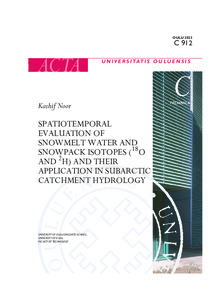Spatiotemporal evaluation of snowmelt water and snowpack isotopes (<sup>18</sup>O and <sup>2</sup>H) and their application in subarctic catchment hydrology
Noor, Kashif (2023-11-28)
https://urn.fi/URN:ISBN:9789526239064
Kuvaus
Tiivistelmä
Abstract
Snow plays a significant role in hydrological studies in cold climates because of its importance for runoff and recharge, provision of water for water supply and energy production, etc. In this thesis, we evaluated snow, with a particular focus on snowmelt processes, from the perspective of stable water isotope (δ18O and δ2H) hydrology. δ18O and δ2H isotopes possess unique fingerprinting properties and are valuable in various snow hydrological applications, including source water identification, quantitative partitioning of water sources and their mixing, and estimating water residence times within catchments. We aimed to answer the following research questions: (i) how do isotope values change vertically across the snow layers in the snowpack? (ii) how do snowmelt isotope values evolve spatiotemporally? and (iii) how do different sampling methods and mathematical approximations of meltwater isotopes influence the extent of potential bias in estimating snowmelt water’s contribution to streamflow?
An analysis of the isotope datasets revealed distinct isotopic stratigraphy in the snowpack layers over winter, with an enriched base layer and spatially consistent stratigraphy across the Pallas catchment. Vertical isotope profiles homogenized during the peak melt period, showing an average of 1 to 2‰ higher δ18O values than before melting. Snowmelt rate influenced liquid-ice fractionation, with pronounced fractionation effects during low melt rates, leading to the depletion of heavy isotopes in initial meltwater samples. Before the peak melt period, meltwater was isotopically heavier and more variable than the depth-integrated snowpack, exhibiting a disparity of approximately 3.1‰ in δ18O, which diminished during the peak melt period. By using δ18O data from snowfall, snowpack, and meltwater, we quantified the biases and estimated the total contribution of snowmelt water to streamflow during the snowmelt period.
If meltwater samples are unavailable, snowpack isotopes during peak melt period can yield reasonably reliable estimates of meltwater contribution to streamflow, albeit with minor underestimations. Meltwater δ18O and δ2H isotopes can better constrain tracer-based ecohydrological models and can enhance our insights into the evolving role of snowmelt. This has profound implications for the hydrological and ecohydrological processes of cold-region catchments.
Tiivistelmä
Lumi on merkittävässä roolissa kylmien alueiden hydrologiassa. Lumen sulamisvedet ovat tärkeitä vesihuollon, pohjaveden muodostumisen, energiantuotannon, tulvien hallinnan ja maaperän eroosion kannalta. Tässä väitöstyössä arvioimme lunta, erityisesti lumen sulamisprosesseja, veden stabiileja isotooppeja (δ18O ja δ2H) hyödyntäen. Tutkimuksen tavoitteena oli vastata seuraaviin kysymyksiin: (i) Miten isotooppiarvot vaihtelevat pystysuunnassa lumen eri kerroksissa? (ii) Miten sulavan lumen isotooppiarvot muuttuvat ajallisesti ja alueellisesti? (iii) Miten voimme paremmin arvioida sulavan lumen osuutta purovirtaamassa käyttäen isotooppimenetelmiä ja arvioida analyysin epävarmuuksia?
Lumiprofiilista kerätyt isotooppinäytteet paljastivat selkeän lumipeitteen isotooppisen kerrostuneisuuden. Lumen pohjakerrokset olivat rikastuneet raskailla isotoopeilla, ja lumipatjan kerrosrakenne oli yhtenäinen koko Pallaksen tutkimusalueella. Lumen nopean sulamisen aikana pystysuuntainen isotooppikerrosrakenne muuttui homogeeniseksi, osoittaen keskimäärin 1–2 ‰ korkeampia δ18O arvoja kuin ennen sulamista. Lumen sulamisvesien alkujakso koostui kevyemmistä isotoopeista, muuttuen loppuvaiheessa raskaampiin isotooppeihin. Lumen sulamisnopeus vaikutti nesteen ja jään väliseen isotooppien fraktioitumiseen etenkin lumen hitaan sulamisen aikana. Erot isotooppiarvoissa sulavan lumen ja lumipeitteen välillä vähenivät sulamisen huippujakson aikana.
Käyttämällä veden isotooppinäytteitä arvioimme lumen sulamisveden kokonaisosuuden purovirtaamassa sulamiskauden aikana. Lisäksi analysoimme systemaattisia virheitä, jotka muodostuvat, jos lumen sulantanäytteiden sijaan analyysissä käytetään veden isotooppinäytteitä lumisateesta tai lumipatjasta. Jos isotooppinäytteitä lumen sulamisvedestä ei ole saatavilla, lumen sulantahuipun aikana kerätyt näytteet lumenpatjan isotooppikoostumuksesta voivat antaa kohtuullisen luotettavia arvioita, vaikkakin hieman aliarvioiden lumen osuutta.
Kaiken kaikkiaan tutkimuksemme korostaa tarvetta tarkempaan lumen sulamisveden δ18O ja δ2H arvojen määritykseen ekohydrologisissa tutkimuksissa. Aineistoja lumen sulamisveden isotooppikoostumuksesta voidaan hyödyntää isotooppeja merkkiaineena käyttävissä ekohydrologisissa malleissa, sekä lisäämään tietoa hydrologisista ja ekohydrologisista prosesseista lumivaikutteisilla alueilla.
Original papers
Original papers are not included in the electronic version of the dissertation.
Ala-aho, P., Welker, J. M., Bailey, H., Højlund Pedersen, S., Kopec, B., Klein, E., Mellat, M., Mustonen, K.-R., Noor, K., & Marttila, H. (2021). Arctic snow isotope hydrology: A comparative snow-water vapor study. Atmosphere, 12(2), 150. https://doi.org/10.3390/atmos12020150
Noor, K., Marttila, H., Klöve, B., Welker, J. M., & Ala‐aho, P. (2023). The spatiotemporal variability of snowpack and snowmelt water 18O and 2H isotopes in a subarctic catchment. Water Resources Research, 59(1), e2022WR033101. https://doi.org/10.1029/2022WR033101
Noor, K., Marttila, H., Welker, J. M., Mustonen, K.-R., Kløve, B., & Ala-aho, P. (2023). Snow sampling strategy can bias estimation of meltwater fractions in isotope hydrograph separation. Journal of Hydrology, 627, 130429. https://doi.org/10.1016/j.jhydrol.2023.130429
Osajulkaisut
Osajulkaisut eivät sisälly väitöskirjan elektroniseen versioon.
Ala-aho, P., Welker, J. M., Bailey, H., Højlund Pedersen, S., Kopec, B., Klein, E., Mellat, M., Mustonen, K.-R., Noor, K., & Marttila, H. (2021). Arctic snow isotope hydrology: A comparative snow-water vapor study. Atmosphere, 12(2), 150. https://doi.org/10.3390/atmos12020150
Noor, K., Marttila, H., Klöve, B., Welker, J. M., & Ala‐aho, P. (2023). The spatiotemporal variability of snowpack and snowmelt water 18O and 2H isotopes in a subarctic catchment. Water Resources Research, 59(1), e2022WR033101. https://doi.org/10.1029/2022WR033101
Noor, K., Marttila, H., Welker, J. M., Mustonen, K.-R., Kløve, B., & Ala-aho, P. (2023). Snow sampling strategy can bias estimation of meltwater fractions in isotope hydrograph separation. Journal of Hydrology, 627, 130429. https://doi.org/10.1016/j.jhydrol.2023.130429
Kokoelmat
- Avoin saatavuus [32049]
